
The History of Cambodia through its flag
The flag, known as tung cheat (Cambodian pavilion) in Khmer, is a powerful symbol of the nation, deeply tied to the history and politics of the country. Cambodia's recent history has been marked by coups, invasions, and occupations that not only led to regime changes but also prompted numerous transformations of the national flag. Since 1863, there have been more than nine different national flags, including periods when multiple Cambodian flags were used simultaneously!
Pre-Protectorate period
In 1863, following events such as the conquest of Siam to the west and Annam to the east, the Khmer "nation" became weakened. The French protectorate, established at the request of King Norodom, granted Cambodia a distinct political status.
The pre-protectorate flag is more accurately described as a pennant, a small flag typically used as an emblem or rallying point. This unique flag style was rarely employed by other countries in recent centuries.
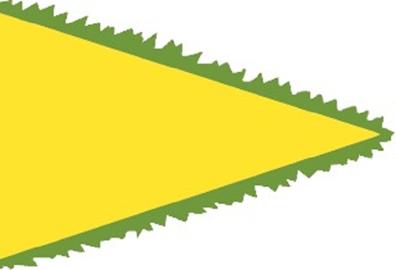
The French Protectorate of Cambodia
Cambodia became a French protectorate in 1863 and adopted its flag in the same year. The colors blue, white, and red are common to many countries in East and Southeast Asia, and are also the colors of the French flag, so it is not surprising that they were used during the protectorate period.
In fact, red and blue were the traditional colors of the Khmer Empire from the 9th century. The blue color of the flag surrounds the entire design, symbolizing the royalty of Cambodia, while the red in the center represents the nation, and the white is reserved for religion, primarily Buddhism.
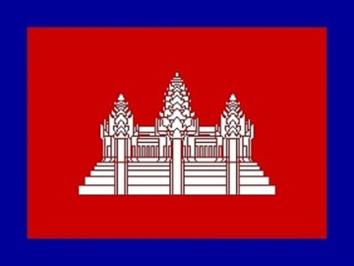
Japanese Occupation
During World War II, from March to October 1945, Cambodia became part of the Greater East Asia Co-Prosperity Sphere, managed and occupied by Japan until its surrender, which led to the creation of a new flag.
This flag remains a mystery to this day, as it did not resemble either the national flag or the Japanese military war flag. Japanese occupations in other Asian countries typically used the national flag of Japan.
https://www.voyagecambodge.com/cdn/wordpress/kh_1/2018/09/jap-flag.jpg-FILL-w350h233.png
The Kingdom of Cambodia
Although the flag was first used in 1948, Cambodia officially gained independence as the Kingdom of Cambodia in 1953 when Norodom Sihanouk became both King, Prime Minister, and Head of State. It was at this point that the current flag of the country was introduced.
The Cambodian flag is the only national flag to feature a real building in its design. The depiction of Angkor Wat is outlined in black. Buddhism was a significant theme during Sihanouk's reign, both as king and as a politician after his abdication in 1955. Angkor Wat is considered a symbol of national, cultural, and religious pride, located in the mythical capital of the Khmer Empire, Angkor. It is the largest architectural and archaeological treasure of the country!
"In a ruthless world," said Sihanouk in an interview with a New York Times journalist, "the survival of a small country like Cambodia depends on your god and my Buddha."
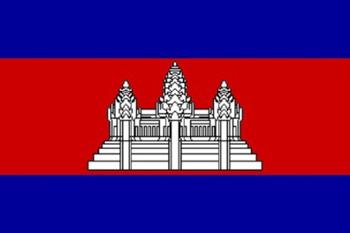
The Khmer Republic
The country’s ruler, King Norodom Sihanouk, was overthrown in March 1970 by General Lon Nol, who had been appointed Prime Minister by Sihanouk in 1966.
In contrast to Sihanouk, the Lon Nol regime facilitated U.S. foreign policy in Southeast Asia, developed by Nixon and Kissinger. Throughout the Vietnam War, the U.S. military bombed the eastern provinces of Cambodia for eight years. This also led many peasants into the arms of the Khmer Rouge guerrilla movement led by Pol Pot.
Angkor Wat now featured red outlines, similar to the French protectorate flag. According to the constitution, the three stars represented three elements: the nation, the republic, and Buddhism. It also referred to the three branches of government (legislative, executive, and judicial) and the three jewels of Buddhism (Buddha, Dharma, and Sangha).
https://www.voyagecambodge.com/cdn/wordpress/kh_1/2018/09/flag70-75-FILL-w364h248.jpg
Democratic Kampuchea
After months of fighting, the Khmer Rouge seized Phnom Penh in April 1975 and forcibly evacuated the capital. Millions of people were displaced, disappeared, and killed, decimating over 20% of the population.
The flag used during this period closely resembled the Vietnamese flag. Instead of a five-pointed yellow star on a red background, it featured a three-branched representation of Angkor Wat without any borders or outlines. The flag's simplistic design reflected a political philosophy that preached simplicity and minimized creativity.
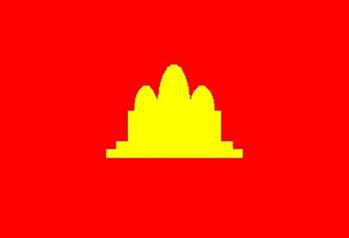
People's Republic of Kampuchea
In January 1979, Heng Samrin and Hun Sen, with Vietnamese troops, invaded Cambodia to oust the Khmer Rouge from power. When the People's Republic of Kampuchea was declared, the country was devastated: the educated class, food, and medical care were nonexistent, and infrastructure was at a very low level.
The flag of the People's Republic of Kampuchea retained a similar design to the flag of Democratic Kampuchea, with the notable change of the five towers of Angkor Wat, which were increased from three to five.
This flag had originally been used by the Khmer Issarak resistance group (“Free Khmer”) after World War II until Cambodia's official independence in 1953. It was later used by the Vietnamese group, Kampuchean United Front for National Salvation. The group viewed their struggle against the Khmer Rouge as akin to the fight against imperial France.
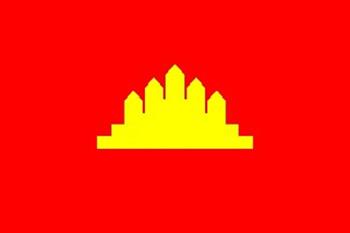
State of Cambodia
In 1989, Hun Sen's administration renamed the country the State of Cambodia, likely to distance itself from the negative connotations associated with the word "Kampuchea."
The new flag reintroduced the complex design of Angkor Wat, once again outlined in black, but with five towers representing various industries in Cambodia: soldiers, merchants, workers, peasants, and intellectuals.
The country remained in a state of civil war, with Khmer Rouge strongholds around the Thai border and the new government of the State of Cambodia on the other side. This situation lasted until the signing of the Paris Peace Agreements in 1991.
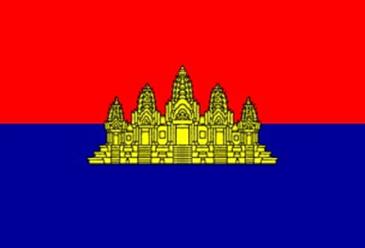
United Nations Transitional Authority in Cambodia (UNTAC)
UNTAC marked the first time the United Nations took on the administration of a sovereign member state. Led by Sergio de Mello, diplomatic staff traveled through Khmer Rouge territory to negotiate its disarmament, which ultimately failed. Following the 1993 elections, a coalition government was formed between the royalist FUNCINPEC party, led by Prince Norodom Ranariddh, and the Cambodian People's Party, led by Hun Sen.
UNTAC’s flag followed the United Nations’ usual format: a blue background with the geographical area of Cambodia depicted in white, with the word “Kampuchea” spelled in Khmer.
This was the first measure taken in Cambodia to resolve a decades-long conflict. However, the arrival of international institutions left Cambodia heavily reliant on foreign aid.
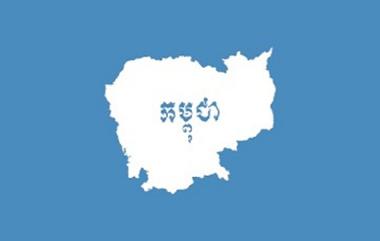
After the departure of the United Nations, the country was renamed the Kingdom of Cambodia, and the flag returned to the one used during the final period of the Kingdom of Cambodia. The Cambodian people and their flag have endured years of instability and upheaval. The perseverance symbolized by the blue on their flag has seen them survive the hard years and emerge free from these devastating times.